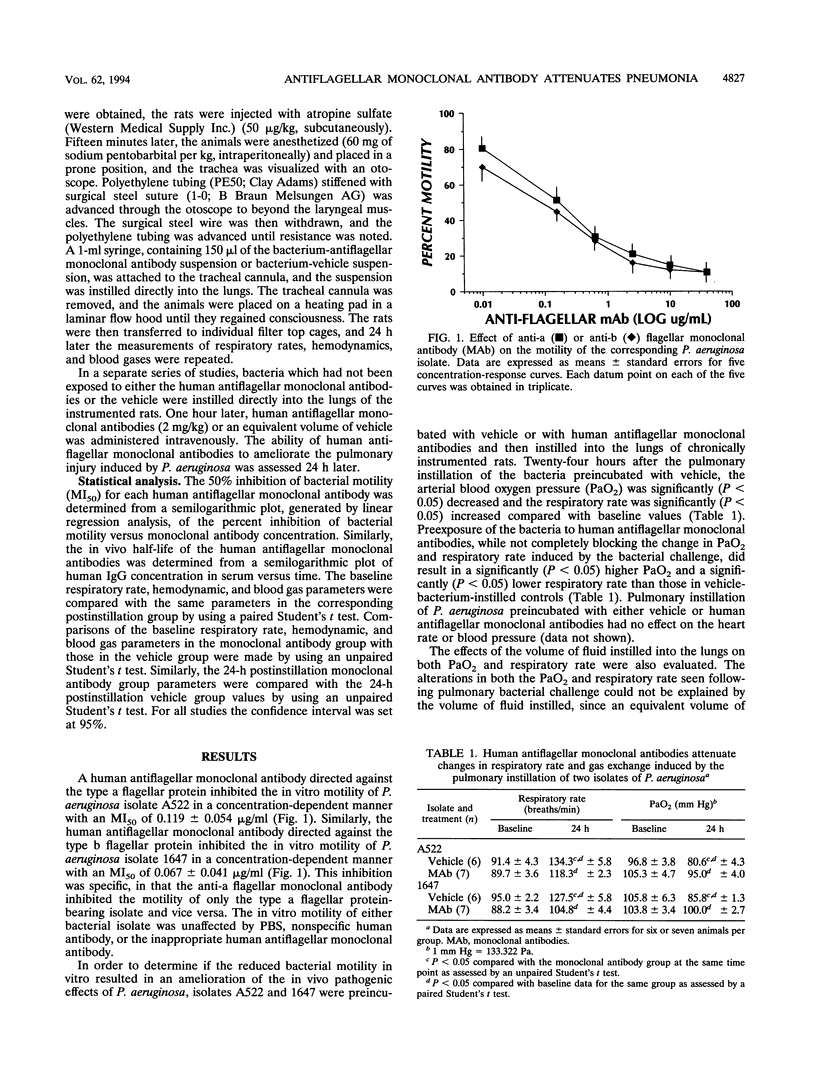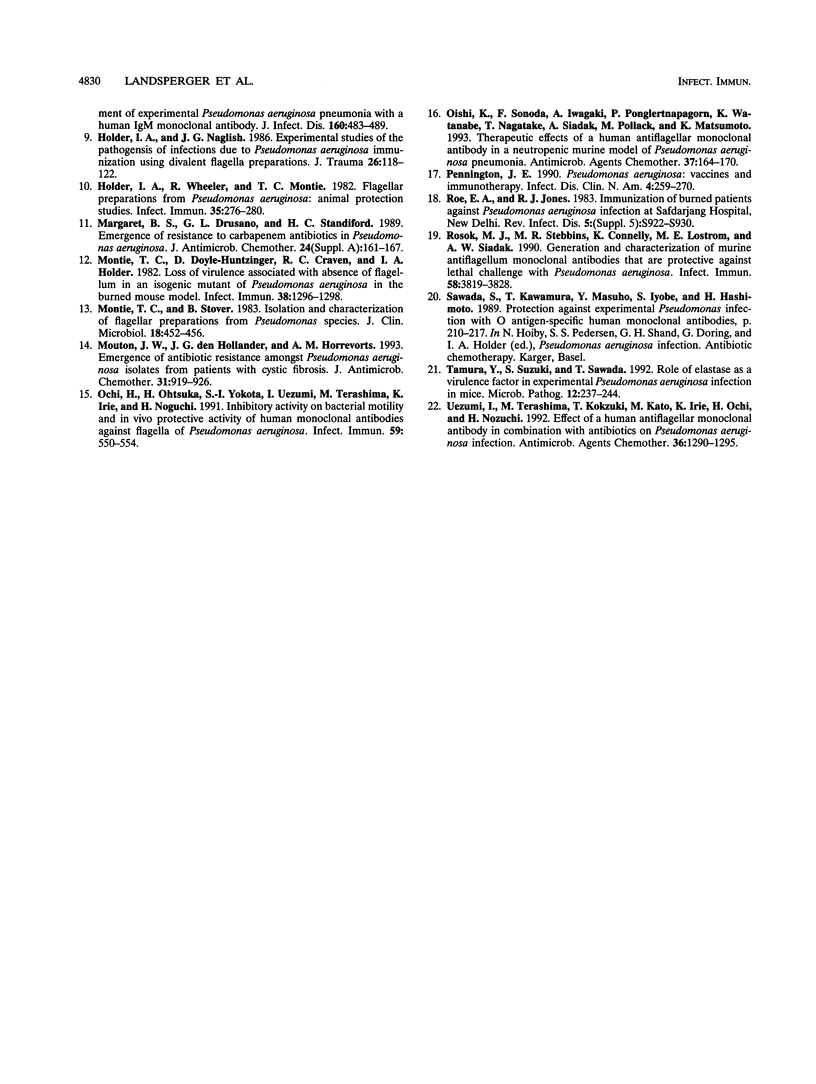Abstract
Two human monoclonal antibodies, directed against the type a and type b flagellar proteins of Pseudomonas aeruginosa, inhibited bacterial motility in vitro specifically and in a concentration-dependent manner. In order to determine if this decreased bacterial motility was associated with a decreased pathogenicity, the ability of these human antiflagellar monoclonal antibodies to attenuate P. aeruginosa-induced pneumonia in the rat was assessed. Incubation of P. aeruginosa with a 1:1 mixture of the human antiflagellar monoclonal antibodies prior to pulmonary instillation significantly (P < 0.05) ameliorated the bacterium-induced decrease in arterial blood oxygen pressure, blunted the increase in respiratory rate, and markedly reduced the area of pulmonary inflammation. Similarly, intravenous administration of the human antiflagellar monoclonal antibodies 1 h after pulmonary instillation of the bacteria also reduced the in vivo pathogenicity of P. aeruginosa. Therefore, human antiflagellar monoclonal antibodies can decrease the in vitro motility of P. aeruginosa and can reduce its in vivo pathogenicity when administered either before or after bacterial challenge.
Full text
PDF





Selected References
These references are in PubMed. This may not be the complete list of references from this article.
- Allison J. S., Dawson M., Drake D., Montie T. C. Electrophoretic separation and molecular weight characterization of Pseudomonas aeruginosa H-antigen flagellins. Infect Immun. 1985 Sep;49(3):770–774. doi: 10.1128/iai.49.3.770-774.1985. [DOI] [PMC free article] [PubMed] [Google Scholar]
- Anderson T. R., Montie T. C., Murphy M. D., McCarthy V. P. Pseudomonas aeruginosa flagellar antibodies in patients with cystic fibrosis. J Clin Microbiol. 1989 Dec;27(12):2789–2793. doi: 10.1128/jcm.27.12.2789-2793.1989. [DOI] [PMC free article] [PubMed] [Google Scholar]
- Azghani A. O., Kondepudi A. Y., Johnson A. R. Interaction of Pseudomonas aeruginosa with human lung fibroblasts: role of bacterial elastase. Am J Respir Cell Mol Biol. 1992 Jun;6(6):652–657. doi: 10.1165/ajrcmb/6.6.652. [DOI] [PubMed] [Google Scholar]
- Brauner A., Cryz S. J., Granström M., Hanson H. S., Löfstrand L., Strandvik B., Wretlind B. Immunoglobulin G antibodies to Pseudomonas aeruginosa lipopolysaccharides and exotoxin A in patients with cystic fibrosis or bacteremia. Eur J Clin Microbiol Infect Dis. 1993 Jun;12(6):430–436. doi: 10.1007/BF01967437. [DOI] [PubMed] [Google Scholar]
- Cross A. S., Opal S. M., Palardy J. E., Bodmer M. W., Sadoff J. C. The efficacy of combination immunotherapy in experimental Pseudomonas sepsis. J Infect Dis. 1993 Jan;167(1):112–118. doi: 10.1093/infdis/167.1.112. [DOI] [PubMed] [Google Scholar]
- Drake D., Montie T. C. Flagella, motility and invasive virulence of Pseudomonas aeruginosa. J Gen Microbiol. 1988 Jan;134(1):43–52. doi: 10.1099/00221287-134-1-43. [DOI] [PubMed] [Google Scholar]
- Döring G., Dauner H. M. Clearance of Pseudomonas aeruginosa in different rat lung models. Am Rev Respir Dis. 1988 Nov;138(5):1249–1253. doi: 10.1164/ajrccm/138.5.1249. [DOI] [PubMed] [Google Scholar]
- Holder I. A., Naglich J. G. Experimental studies of the pathogenesis of infections due to Pseudomonas aeruginosa: immunization using divalent flagella preparations. J Trauma. 1986 Feb;26(2):118–122. doi: 10.1097/00005373-198602000-00003. [DOI] [PubMed] [Google Scholar]
- Holder I. A., Wheeler R., Montie T. C. Flagellar preparations from Pseudomonas aeruginosa: animal protection studies. Infect Immun. 1982 Jan;35(1):276–280. doi: 10.1128/iai.35.1.276-280.1982. [DOI] [PMC free article] [PubMed] [Google Scholar]
- Margaret B. S., Drusano G. L., Standiford H. C. Emergence of resistance to carbapenem antibiotics in Pseudomonas aeruginosa. J Antimicrob Chemother. 1989 Sep;24 (Suppl A):161–167. doi: 10.1093/jac/24.suppl_a.161. [DOI] [PubMed] [Google Scholar]
- Montie T. C., Doyle-Huntzinger D., Craven R. C., Holder I. A. Loss of virulence associated with absence of flagellum in an isogenic mutant of Pseudomonas aeruginosa in the burned-mouse model. Infect Immun. 1982 Dec;38(3):1296–1298. doi: 10.1128/iai.38.3.1296-1298.1982. [DOI] [PMC free article] [PubMed] [Google Scholar]
- Montie T. C., Stover G. B. Isolation and characterization of flagellar preparations from Pseudomonas species. J Clin Microbiol. 1983 Sep;18(3):452–456. doi: 10.1128/jcm.18.3.452-456.1983. [DOI] [PMC free article] [PubMed] [Google Scholar]
- Mouton J. W., den Hollander J. G., Horrevorts A. M. Emergence of antibiotic resistance amongst Pseudomonas aeruginosa isolates from patients with cystic fibrosis. J Antimicrob Chemother. 1993 Jun;31(6):919–926. doi: 10.1093/jac/31.6.919. [DOI] [PubMed] [Google Scholar]
- Ochi H., Ohtsuka H., Yokota S., Uezumi I., Terashima M., Irie K., Noguchi H. Inhibitory activity on bacterial motility and in vivo protective activity of human monoclonal antibodies against flagella of Pseudomonas aeruginosa. Infect Immun. 1991 Feb;59(2):550–554. doi: 10.1128/iai.59.2.550-554.1991. [DOI] [PMC free article] [PubMed] [Google Scholar]
- Oishi K., Sonoda F., Iwagaki A., Ponglertnapagorn P., Watanabe K., Nagatake T., Siadak A., Pollack M., Matsumoto K. Therapeutic effects of a human antiflagella monoclonal antibody in a neutropenic murine model of Pseudomonas aeruginosa pneumonia. Antimicrob Agents Chemother. 1993 Feb;37(2):164–170. doi: 10.1128/aac.37.2.164. [DOI] [PMC free article] [PubMed] [Google Scholar]
- Pennington J. E. Pseudomonas aeruginosa. Vaccines and immunotherapy. Infect Dis Clin North Am. 1990 Jun;4(2):259–270. [PubMed] [Google Scholar]
- Roe E. A., Jones R. J. Immunization of burned patients against Pseudomonas aeruginosa infection at Safdarjang Hospital, New Delhi. Rev Infect Dis. 1983 Nov-Dec;5 (Suppl 5):S922–S930. doi: 10.1093/clinids/5.supplement_5.s922. [DOI] [PubMed] [Google Scholar]
- Rosok M. J., Stebbins M. R., Connelly K., Lostrom M. E., Siadak A. W. Generation and characterization of murine antiflagellum monoclonal antibodies that are protective against lethal challenge with Pseudomonas aeruginosa. Infect Immun. 1990 Dec;58(12):3819–3828. doi: 10.1128/iai.58.12.3819-3828.1990. [DOI] [PMC free article] [PubMed] [Google Scholar]
- Sawada S., Kawamura T., Masuho Y., Iyobe S., Hashimoto H. Protection against experimental Pseudomonas infection with O antigen-specific human monoclonal antibodies. Antibiot Chemother (1971) 1989;42:210–217. doi: 10.1159/000417622. [DOI] [PubMed] [Google Scholar]
- Tamura Y., Suzuki S., Sawada T. Role of elastase as a virulence factor in experimental Pseudomonas aeruginosa infection in mice. Microb Pathog. 1992 Mar;12(3):237–244. doi: 10.1016/0882-4010(92)90058-v. [DOI] [PubMed] [Google Scholar]
- Uezumi I., Terashima M., Kohzuki T., Kato M., Irie K., Ochi H., Noguchi H. Effects of a human antiflagellar monoclonal antibody in combination with antibiotics on Pseudomonas aeruginosa infection. Antimicrob Agents Chemother. 1992 Jun;36(6):1290–1295. doi: 10.1128/aac.36.6.1290. [DOI] [PMC free article] [PubMed] [Google Scholar]


